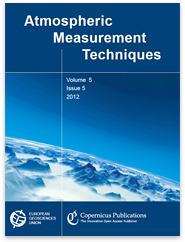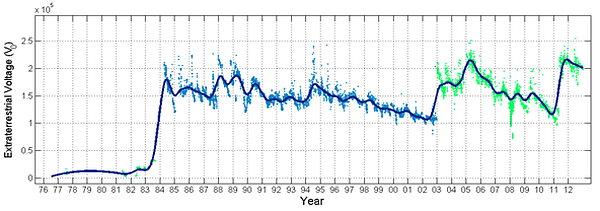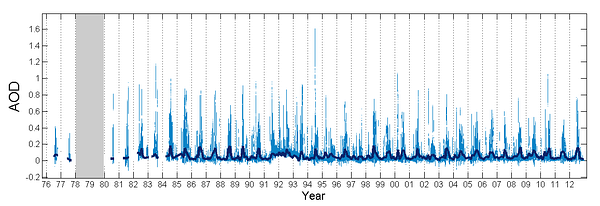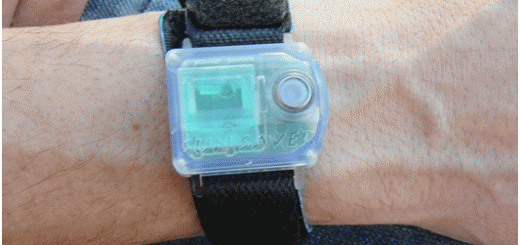Recovering Long-term Aerosol Optical Depth Series (1976-2012) from an Astronomical Potassium-based Resonance Scattering Spectrometer
![]()

This is the title of the paper published by Africa Barreto, Emilio Cuevas, Pere Pallé, Pedro Miguel Romero, Fernando Almansa, and Christoph Wehrli in Atmospheric Measurement Techniques.
It is well known that long-term measurements are the most important approach for detection of changes in atmospheric composition caused by either variation in natural or anthropogenic emissions, as well as in atmospheric processes and sinks, in order to reveal the spatial and temporal variability of Earth’s climate. This information is crucial in the diagnosis of current and past climate as well as in the projections of future climate change. Unfortunately, due to the lack of availability of reliable multi-year observations, long-term trend analyses of aerosol concentration at present rarely exceed more than 20 years. It means that the existing datasets are difficult to be used for most scientific assessments because they are fragmented or not long enough for these purposes.
A recent scientific collaboration between the Izaña Atmospheric Research Center (AEMET) and Instituto de Astrofísica de Canarias (IAC) has implied the recovering of a long term series of AOD for Izaña Mountain (Canary Islands, Spain) retrieved using the Mark-I potassium-based resonant scattering spectrometer, recently published in the Atmospheric Measurement Techniques Discussions (AMTD). It presents a 37-yr series of AOD information that can be considered as one of the longest AOD existing dataseries in the world, with aerosol information from 1976 onwards. The instrument operation is based on the method of resonant scattering, which presents a long-term stability and high precision in comparison to other instruments based on interference filters. However, it has been specifically designed as a reference instrument for helioseismology and its ability to determine AOD from transmitted and scattered monochromatic radiation at 769.9 nm inside a potassium vapor cell in the presence of a permanent magnetic field is evaluated in this work (see Fig. 1). Particularly, the use of an exposed mirrors arrangement to collect sunlight as well as the Sun-laboratory velocity dependence of the scattered component introduces some inconveniences when we perform the instrument calibration. The authors of this paper have solved the first problem using a quasi-continuous Langley calibration technique and a refinement procedure to correct for calibration errors as well as for the fictitious diurnal cycle on AOD data. The yearly variation in the Mark-I calibration can be clearly observed in Fig. 2.

Fig. 1: Mark-I coelostat system at the entrance of the spectrometer, on the left, and short diagram of the main constituents of the Mark-I spectrometer on the right.
The comparative analysis between the recovered AOD dataset from Mark-I and collocated quasi-simultaneous data from Cimel AErosol RObotic NETwork (AERONET) and Precision Filter Radiometer (PFR) instruments showed an absolute mean bias ≤0.01 in the 11-yr and 12-yr comparison, respectively, what constitutes an excellent result. The yearly validation performed in all cases by means of Cimel-AERONET/Mark-I and PFR/Mark-I comparison showed low MB values ≤0.02, within the precision of both sunphotometers (Cimel and PFR) and high correlation coefficients (generally r>0.90).
The 37-yr AOD series determined with Mark-I as well as the long term monthly variation of the homogenized data set are shown in Fig. 3, in which the impact of volcanic events like the El Chichón eruption in 1982 and the Mt. Pinatubo eruption in 1991 are clearly detected. From the homogenized monthly series the authors have assessed the AOD anomalies caused by these two important volcanic events. These anomalies are the AOD differences regarding the average AOD of the period 1984-1993. The AOD anomaly observed after El Chichón eruption in 1982 was 0.016, while the anomalies were significantly lower (0.005) in 1983. In the case of Mt. Pinatubo, the anomalies observed after the eruption were more important and persistent than for El Chichón eruption, recording a peak in 1992 with an AOD anomaly of 0.020. The effects of Mt. Pinatubo eruption in AOD were not significantly reduced until early 1993.

Fig. 2: Mark-I extraterrestrial voltage (V0) variation extracted from the scattered (in green) and the transmitted component (in blue) within the time interval from 1976 to 2012. The smoothing cubic spline is displayed in the blue line.
The analysis of the decadal AOD average at Izaña developed by the authors estimated that AOD remained nearly stable at 0.05 since 1984, with values of 0.056 in 1984-1993 decade, 0.051 in 1994- 2003 decade and 0.056 in the period 2004-2012. These results do not show the expected decrease in AOD as a result of the solar brightening effect. However, we have to keep in mind, first, that IZO is representative of subtropical free troposphere conditions, with associated very low AOD background values, and hence less affected by continental pollution, and secondly, the decisive role played by Saharan dust intrusions in the region of study, basically in summertime, which shows significant inter-annual and decadal variations modulating the long-term AOD series.

Fig. 3: Long-term AOD (at 769.9 nm) variation at Izaña extracted from Mark-I scattered data (from 1976 to 1983 as well as from 2003 to 2012) and transmitted data (from 1984 to 2002). Monthly mean of the homogenized AOD series is displayed through the blue line. No available data from 1978 to 1980.
Finally, the trend analysis in AOD at Izaña performed by the authors indicated there is a negligible reduction in AOD<0.001 from 1984 to 2012. This result is consistent with the no statistically significant trend in AOD found by other papers in the literature by using long-term aerosol concentration measurements at high-altitude stations. The decadal trend analysis over the period 1984 to 2012 revealed that only the period 1984-1993 exhibited a significant AOD reduction of -0.047/decade (with significance at 95% confidence level).
This work reveals the ability of Mark-I to retrieve AOD with an estimated accuracy ≤0.03. This allows to extend the long-term AOD series at Izaña site with PFR and Cimel (since 2001 and 2003, respectively) back until 1976 using AOD data from Mark-I. This unique long-term data series is suitable to be used in future analysis of aerosol trends and inter-annual aerosol variability, critical for studying long-term variations of dust events and the modulation of AOD as a result of this variability.
Further details about this study can be found in the on-line paper:
Barreto, A., Cuevas, E., Pallé, P., Romero, P. M., Almansa, F. and Wehrli, C: Recovering Long-term Aerosol Optical Depth Series (1976–2012) from an Astronomical Potassium-based Resonance Scattering Spectrometer, Atmos. Meas. Tech. Discuss., 7, 1–29, 2014.
http://www.atmos-meas-tech-discuss.net/7/4093/2014/amtd-7-4093-2014.html






